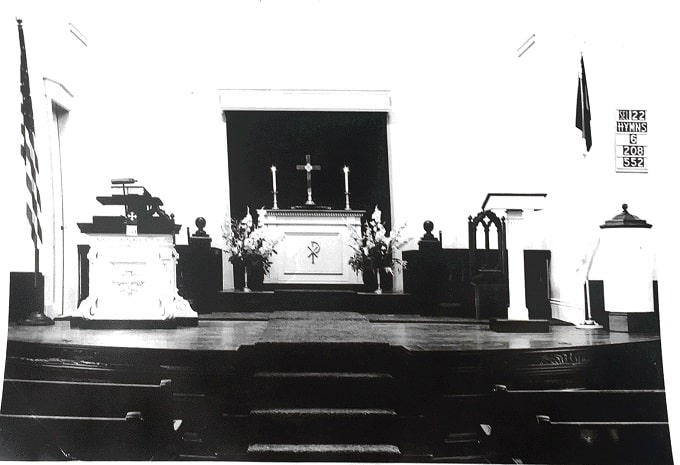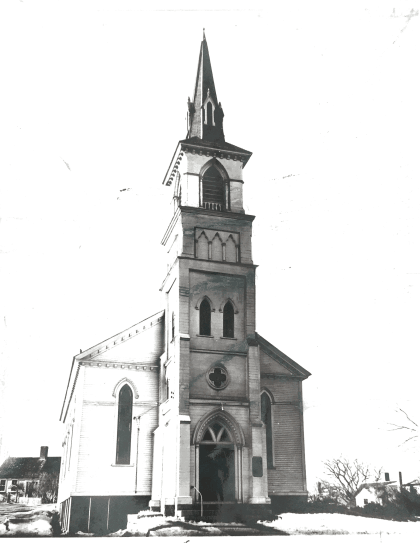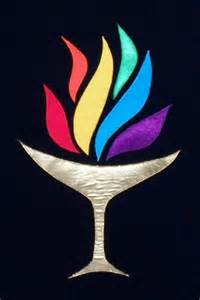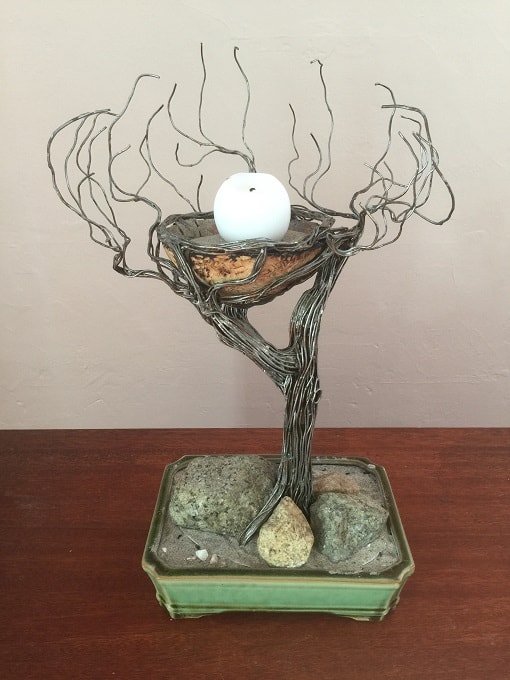Our History & Chalice
Our History
“You may possess only a small light, but uncover it, let it shine, use it in order to bring more light and understanding to the hearts and minds of men and women.”
John Murray, Founder of American Universalism
John Murray established Universalism in Gloucester, MA in 1779. In 1807, Rockport members of the Gloucester church began holding services in a local school. On February 11, 1821, the first Universalist church in America, the Universalist Benevolent Society in Sandy Bay, was born when 23 Founders signed this “Compact”: “We whose names are hereunto subscribed, being sensible of the unchangeable and universal love of God to Mankind, and in humble thankfulness to Him, disposing our hearts to unite together in the bonds of love and friendship: think it our duty as tending to the good of society in general and the improvement and edification of each other in particular, to form ourselves into a religious society.”
When the Rockport and Gloucester congregations officially separated in 1845, we established our name as The First Universalist Society of Rockport. In 1961, we added Unitarian to our name, then in 2003 dropped First, to be The Unitarian Universalist Society of Rockport. We are a member congregation of the Unitarian Universalist Association
In 1843, we prepared resolutions against slavery, intemperance, and war. In 1861, a person threw a smoking bomb through a window into our sanctuary, during an anti-slavery lecture by a noted abolitionist. The crowd evacuated, but later returned to hear the rest of the talk. In 1884, our Society hired its first female pastor, Lorenza Haynes, past Chaplain to The Maine Senate and House. We ordained three more women into ministry since 1971. In the 1960’s members were involved in the anti-war and civil rights movements. For decades through the 1980s, the Murray League, a woman’s  fellowship group gave hospitality and sociability to people from all over the North Shore. They hosted a Monday Morning Coffee Break, serving handmade donuts, muffins, pancakes, and fried dough, which supported the church’s work.
fellowship group gave hospitality and sociability to people from all over the North Shore. They hosted a Monday Morning Coffee Break, serving handmade donuts, muffins, pancakes, and fried dough, which supported the church’s work.
We participated in the anti-nuclear movement and opposed USA policies in Central America in the 1980’s. Since the 1990’s we have supported ecological awareness, responsible sustainability, and Gay and Lesbian rights. We initiated and still host Rockport’s annual Martin Luther King Jr. Day Commemorations and New Year’s Eve Peace Services. Contemporary social justice concerns include:
- Racial justice
- Women’s and children’s rights
- Central American solidarity work
- Rights of gay, lesbian, bisexual and transgender people
- Immigrant rights
- Affordable housing
- Disaster relief in New Orleans and Haiti.

Our Building
Our current church was built in 1829. We added our historic 93-foot steeple in 1867. In the 1950’s and 1980’s, a Vestry, kitchen, and Friendship Room were added on. In addition, we transformed our organ loft into classrooms and moved our organ to the Sanctuary during this time. In 2017, our steeple was completely redone.
Our Symbol: The Flaming Chalice

A flame within a chalice (a cup with a stem and foot) is a primary symbol of the Unitarian Universalist faith tradition. Many of our congregations kindle a flaming chalice in gatherings and worships and feature the chalice symbol prominently.
“The flaming chalice combines two archetypes – a drinking vessel and a flame – and as a religious symbol has different meanings to different beholders. Chalices, cups, and flagons can be found worldwide on ancient manuscripts and altars…As a sacrificial fire, flame has been a central symbol for the world’s oldest scriptures, the Vedic hymns of India. Today, lights shine on Christmas and Hanukkah, eternal flames stand watch at monuments and tombs, and candles flicker in cathedrals, temples, mosques and meeting houses. A flame can symbolize witness, sacrifice, courage and illumination…The chalice and the flame were brought together as a Unitarian symbol by an Austrian artist, Hans Deutsch, in 1941. Living in Paris during the 1930s, Deutsch drew critical cartoons of Adolf Hitler. When the Nazis invaded Paris in 1940, he fled to the south of France, then to Spain, and finally into Portugal. There, he met the Reverend Charles Joy, executive director of the Unitarian Service Committee (USC now called UUSC). The Service Committee was new, founded in Boston to assist Eastern Europeans, among them Unitarians as well as Jews, who needed to escape Nazi persecution…The USC was an unknown organization in 1941. This was a special handicap in the cloak and dagger world, where establishing trust quickly across barriers of language, nationality, and faith could mean life instead of death…Joy asked Deutsch to create a symbol for their papers “to make them look official, to give dignity and importance to them, and at the same time to symbolize the spirit of our work”…
Thus Han Deutsch made his lasting contribution to the UUSC, and to Unitarian Universalism. With pencil and ink he drew a chalice and a flame…The story of Hans Deutsch reminds us that the symbol of a flaming chalice stood in the beginning for a life of service. When Deutsch designed the flaming chalice, he had never seen a Unitarian or Universalist church or heard a sermon. What he had seen was faith in action – people who were willing to risk all for others, in a time of need.
Today, the flaming chalice is the official symbol of the UU Service Committee and the Unitarian Universalist Association…Perhaps most importantly, it has become a focal point for worship. No one meaning or interpretation is official. The flaming chalice, like our faith, stands open to receive new truths that pass the test of reason, justice, and compassion.” (From the UUA pamphlet The Flaming Chalice by Reverend Danial D Hotchkiss 1993)
To Unitarian Universalists today the flaming chalice is a symbol of hope, the sacred, the quest for truth, the warmth of community, the light of reason, and more.
We light a flaming chalice in worship to create a reverent space for reflection, prayer, meditation, and singing.
Coley Bryan, a UUSR member, created our unique chalice that we use in our worship.
